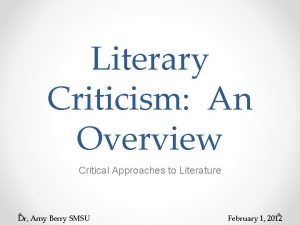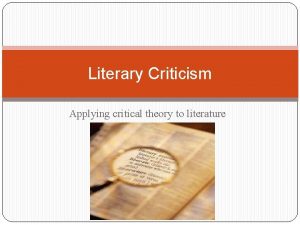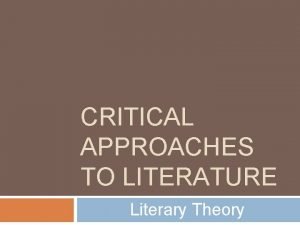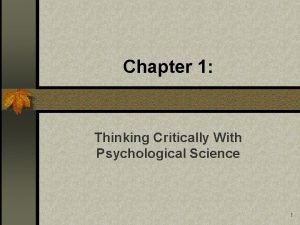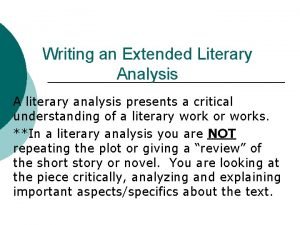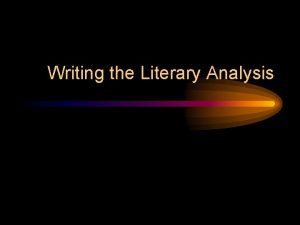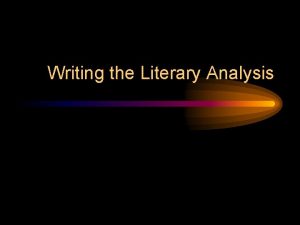Guidelines for Writing a Literary Critical Analysis What









- Slides: 9

Guidelines for Writing a Literary Critical Analysis

� What is a literary critical analysis? A literary critical analysis explains a work of fiction, poetry or drama by means of interpretations. The goal of a literary analysis (as with any other analysis) is to broaden and deepen your understanding of a work of literature. � What is an interpretation? An interpretation is an individual response that addresses meaning. � How do you develop an interpretation? Interpretations are developed by an in-depth

� How do you conduct an "in-depth" examination of a text? 1. Before reading the work, make sure to examine the title carefully. Often the title is a clue to an important idea in the work. 2. Make sure you look up in the dictionary any words with which you are not familiar. 3. After reading the work the first time, ask yourself the following questions: - What is the geographical, historical and social setting? How does this affect the story or poem? - Who is (are) the main character(s)? - Who are the secondary characters, and how are they linked to the main characters? - Does the main character change? If so, how and why? If not, why not? - What is the conflict? Can you trace the development and resolution of the conflict?

4. As you re-read the work, make sure you can answer these questions. Then ask yourself the following questions, which may help you to discover deeper meanings that will lead you to an interpretation. - Can you summarize the author's meaning in one paragraph? - Can you state a theme of the work in one sentence? - Can you identify any symbols or metaphors? What do they mean? � How do you prove your interpretation? You prove your interpretation by finding a pattern of examples in the literature that support your idea. You find this pattern in the literary elements, such as plot, point of view, character, setting, symbols, tone, and style. In poetry, the uses of language (rime, meter and metaphors) are also patterns that can support your

� If interpretations are an individual response, are all interpretations valid? Because an interpretation must be supported, the strength or weakness of your interpretation rests on the strength or weakness of your argument. In other words, you must organize a discussion that convinces the reader that your point of view is astute. � Where do you find evidence to support your interpretation? In a literary analysis evidence is found mainly from the work you are discussing. Secondary sources (published critical analyses) may support your point of view as well. � How much of the story should you retell in a critical analysis? You do need to locate your reader to the scene or section of the poem that you are discussing; therefore, some plot summary is necessary, but re-telling the story or a poem is not considered an analysis. You can assume your reader has read the work. � What should be documented in a critical analysis? Any secondary sources must, of course, be documented. Also, direct quotes should be documented. Unlike secondary sources, a summary of a literary scene or event does not need documentation.

CHAPTER 1 INTRODUCTION �Explaining the overview of playwright biography �Explaining the literary work �Elaborating the drama components (theme, plot, setting, character, mode, conflict, ending)

CHAPTER II LITERARY WORK CRITICISM OF DRAMA 2. 1 Literary Criticism a. Themes in the story Problem with time There is a dispute over the scenario of the play as it is cited at first by Theseus that "four happy days bring in another moon", the wood episode then takes place at a night of no moon, but Lysander asserts that there will be so much light in the very night they will escape that dew on the grass will be shining like liquid pearls. Also, in the next scene, they will rehearse in moonlight which creates a real confusion. It is possible that the Moon set during the night allowing Lysander to escape in the moonlight and for the actors to rehearse, then for the wood episode to occur without moonlight. Theseus's statement can mean four days until the next month.

There are points in the play, however, when there is an absence of patriarchal control. In his book, Power on Display, Leonard Tennenhouse says the problem in A Midsummer Night's Dream is the problem of "authority gone archaic“. The Athenian law requiring a daughter to die if she does not do her father's will is outdated. Tennenhouse contrasts the patriarchal rule of Theseus in Athens with that of Oberon in the carnivalistic Faerie world. The disorder in the land of the faeries completely opposes the world of Athens. He states that during times of carnival and festival, male power is broken down. For example, what happens to the four lovers in the woods as well as Bottom's dream represents chaos that contrasts with Theseus' political order. However, Theseus does not punish the lovers for their disobedience. According to Tennenhouse, by forgiving of the lovers, he has made a distinction between the law of the patriarch (Egeus) and that of the monarch (Theseus), creating two different voices of authority. This distinction can be compared to the time of Elizabeth I in which monarchs were seen as having two bodies: the body natural and the body mystical. Elizabeth's succession itself represented both the voice of a patriarch as well as the voice of a monarch: (1) her father's will which stated that the crown should pass to her and (2) the fact that she was the daughter of a king. The challenge to patriarchal rule in A Midsummer Night's Dream mirrors exactly what was occurring in the age of Elizabeth I.

THANK YOU ^_^
 Critical semi critical and non critical instruments
Critical semi critical and non critical instruments Semicritical
Semicritical Applying critical approaches to literary analysis
Applying critical approaches to literary analysis Applying critical approaches to literary analysis quiz
Applying critical approaches to literary analysis quiz What is a critical lens
What is a critical lens Applying critical approaches to literary analysis
Applying critical approaches to literary analysis Critical thinking guidelines
Critical thinking guidelines Critical thinking guidelines in psychology
Critical thinking guidelines in psychology Similarities of types of journalistic writing
Similarities of types of journalistic writing Compare non-critical readers with critical readers.
Compare non-critical readers with critical readers.


